-
A Podiatrist’s Guide to Plantar Fasciitis
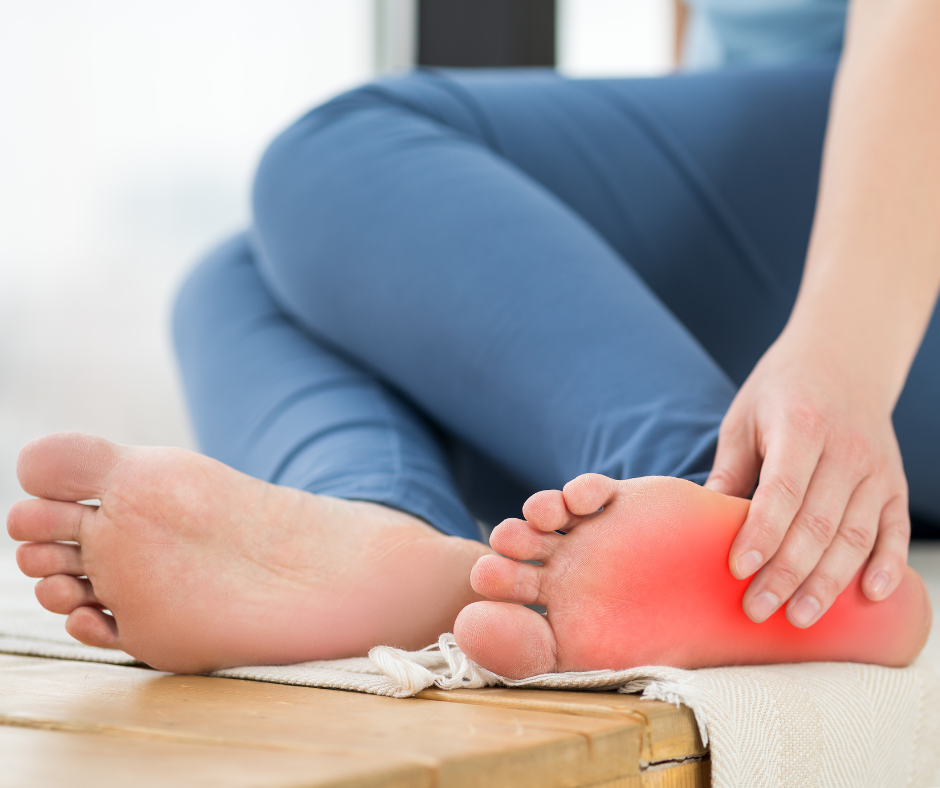
You can’t fix a problem if you don’t even know what it is! That’s often the issue with plantar fasciitis, a common form of chronic heel pain that could affect up to 10% of the population! This time around, Kentlands Foot & Ankle Center will be explaining what defines the condition and which non-invasive treatment options you can trust.
Q: What exactly is plantar fasciitis?
A: Plantar fasciitis is the inflammation of the plantar fascia, a thick band of tissue running along the bottom of your foot, connecting your heel bone to your toes. Think of it as your foot’s built-in shock absorber. When it’s overstressed, it becomes painful.
Q: What does it feel like?
A: The hallmark symptom is stabbing heel pain, especially in the morning or after rest. It often feels better as you move around, then worsens again after activity. Some describe it as a deep ache or burning sensation along the arch.
Q: What causes it?
A: Several factors can contribute:
- Foot Mechanics: Flat feet, high arches, or abnormal walking patterns put extra strain on the plantar fascia.
- Overuse: Runners, walkers, and those who stand for long periods are at higher risk.
- Improper Footwear: Lack of arch support and cushioning.
- Tight Calf Muscles: Limit ankle flexibility, increasing stress on the fascia.
- Obesity: Excess weight adds pressure.
Q: How is it diagnosed?
A: A podiatrist can usually diagnose plantar fasciitis with a physical exam and review of your symptoms. X-rays may be needed to rule out other issues like stress fractures.
Q: How can I fix this without surgery?
A: Good news! About 95% of plantar fasciitis cases improve with non-surgical methods. Here are some key approaches:
- Rest: Reduce activities that aggravate the pain.
- Ice: Apply ice packs or roll a frozen water bottle under your foot for 15-20 minutes, 3-4 times a day.
- Stretching: Gentle stretches for your plantar fascia, Achilles tendon, and calf muscles are crucial.
- Supportive Shoes and Orthotics: Proper arch support and cushioning can redistribute pressure. Custom orthotics are often beneficial.
- Night Splints: These keep your foot flexed while you sleep, stretching the plantar fascia.
- Medications: Over-the-counter pain relievers (NSAIDs) can help with inflammation.
- Physical Therapy: A physical therapist can guide you through stretches, strengthening exercises, and other treatments.
Keep an eye out for future posts and more detailed information on treatments! We’ll explore options like ESWT, which involves using sound waves to stimulate healing in the plantar fascia.
Interested in learning more? We’re always happy to help! Schedule a comprehensive foot examination with Kentlands Foot and Ankle Center podiatrist Dr. Jon M. Sherman. To make your appointment, please call our office at 301-825-9697.
-
Bunion Basics: Understanding That Bump on Your Foot
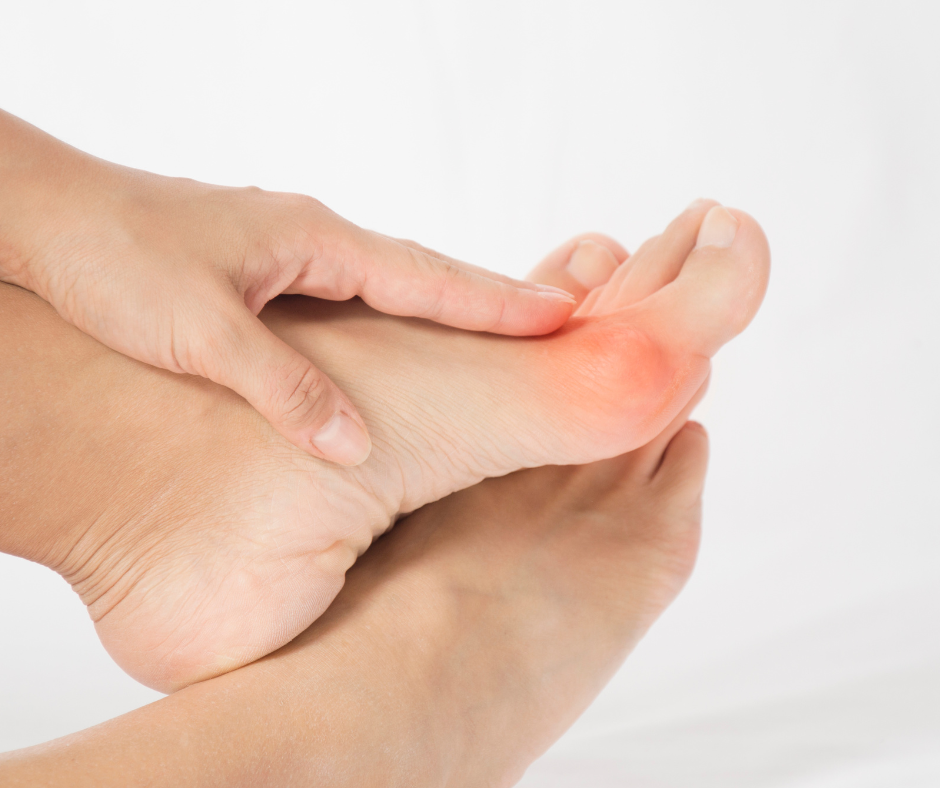
It’s a typical day…until you put on your shoes. That’s when you notice a bony bump forming at the base of your big toe. What is it? How did it get there? And why does it seem to be “drifting” towards your second toe?
If this sounds familiar, you might be dealing with a bunion, medically known as Hallux Valgus. To keep you informed on why bunions form and what to watch for, Kentlands Foot & Ankle Center is breaking down the basics below.
What’s a Bunion?
A bunion isn’t just an overgrowth of bone. It represents a change in the actual bony framework of the front part of your foot.
- The long bone connected to the big toe (the first metatarsal) starts to drift outward, and the big toe itself begins to point inward towards the smaller toes.
- This misalignment creates the characteristic bump on the side of the foot at the base of the big toe.
Bunions are often progressive, meaning they tend to get worse over time if not managed appropriately.
Why Do Bunions Form?
While ill-fitting footwear gets a lot of blame, the primary cause of bunions is usually:
- Heredity: The biggest factor! Certain inherited foot types and faulty foot mechanics (like excessive pronation or flat feet) make you more susceptible to developing bunions. If your parents or grandparents had bunions, you might be more likely to develop them, too.
- Foot Structure & Biomechanics: The way your foot functions when you walk can place abnormal stress on the big toe joint, contributing to the deformity over time.
- Footwear (The Aggravator): While usually not the root cause, shoes that are tight, narrow, or have high heels can definitely aggravate an existing bunion and potentially accelerate its progression. They force the toes into an unnatural position.
Less common causes can include foot injuries or certain types of arthritis.
Spotting the Signs: Bunion Symptom Checklist
How do you know if that bump is truly a bunion? Look for these common signs:
- The Bump: A bony prominence on the side of your foot at the base of the big toe.
- Toe Drift: Your big toe angling towards your second toe.
- Pain or Soreness: Discomfort around the big toe joint, often worse when wearing shoes or after activity.
- Redness & Swelling: Inflammation around the bony bump.
- Corns or Calluses: These can develop on the bump itself, between the big and second toes, or even on the ball of the foot due to altered pressure.
- Restricted Motion: Decreased flexibility or stiffness in your big toe joint.
- Difficulty Fitting Shoes: Finding shoes that are comfortable and don’t irritate the affected area.
Diagnosis Matters!
Even if your bunion isn’t causing significant pain yet, early evaluation allows us to confirm the diagnosis, rule out other conditions, and plan the best course of treatment for your unique needs. Affected? Don’t suffer in silence. Schedule your appointment and move toward relief today!
Interested in learning more? We’re always happy to help! Schedule a comprehensive foot examination with Kentlands Foot & Ankle Center podiatrist Dr. Jon M. Sherman. To make your appointment, please call our office at 301-825-9697.
-
National Diabetes Awareness Month: Do’s and Don’ts

November is National Diabetes Month, so the time is right to emphasize how diabetes impacts both your overall health and your feet in particular.
Kentlands Foot & Ankle Center knows how overwhelming it can be to manage this chronic condition alone, so with that in mind, we’ve gathered some helpful hints and tips to make at-home management far easier. Keep reading to learn the “Do’s and Don’ts” of diabetic foot care, courtesy of our expert team!
DO: Practice Good Nutrition
What you eat directly affects your diabetes management and foot health: high blood sugar can damage nerves and blood vessels, leading to serious complications.
- Do: Load up on fiber-rich foods like whole grains, fruits, vegetables, and legumes. These help regulate blood sugar, promote good digestion, and keep you feeling full for longer.
- Do: Choose lean protein sources like fish, poultry, beans, and lentils for essential nutrients without excess saturated fat.
- Do: Include healthy fats from avocados, nuts, seeds, and olive oil to support heart health.
DON’T: Forget Daily Foot Checks
Early detection is key to preventing serious foot problems.
- Don’t: Skip your daily foot inspection! Look for cuts, blisters, redness, swelling, or any changes in skin color or temperature.
- Don’t: Hesitate to contact your podiatrist if you notice anything unusual! Early intervention makes a big difference.
DO: Schedule Regular Podiatrist Visits
Routine care and regular foot screenings allow for early recognition of problems like ulcers, which can reduce the risk of lower limb amputation by up to 85%.
- Do: See your podiatrist at least once a year for a comprehensive foot exam, even if you don’t have any noticeable problems.
DON’T: Wear Restrictive Footwear
Certain shoe styles can worsen foot problems or restrict circulation.
- Don’t: Wear high heels, tight shoes, or pointed-toe shoes that squeeze your toes.
- Don’t: Wear shoes without proper arch support, especially if you have flat feet.
Wondering what else you can do to manage the complications of diabetes? We’ve got one more “Do” for you, then: give us a call and get in touch today!
Schedule a comprehensive foot examination with Kentlands Foot and Ankle Center podiatrist Dr. Jon M. Sherman. To schedule your appointment, please contact our office at 301-825-9697.
-
5 Common Foot and Ankle Injury Myths in Sports

From little league to professional sports, foot and ankle injuries are some of the most common among athletes. And unfortunately, many misconceptions and myths surround these issues, which can hinder recovery.
In this post, we will debunk these myths to help athletes better address their foot and ankle troubles.
Myth 1: All Ankle Sprains Are the Same.
Fact: Ankle sprains vary in severity, ranging from mild to severe. While most ankle sprains involve the ligaments on the outside of the ankle, some can also affect the ligaments on the inside. That’s why you should seek a medical evaluation to determine the extent of the injury.
Myth 2: You’re Right, Coach. I’ll Rub Some Dirt on It.
Fact: Continuing to play with pain can worsen an injury and delay recovery. If you experience pain in your foot or ankle, it’s important to rest and seek medical attention. Overuse injuries and stress fractures are common for athletes who are too stubborn to stop.
Myth 3: Rest Or Surgery. There’s No In Between.
Fact: While rest is often recommended for minor injuries and surgery is sometimes required for season-ending injuries, there lies a full spectrum of intervention between these two extremes:
- Physical therapy: Exercises to strengthen the surrounding muscles and improve stability.
- Corticosteroid injections: These injections can help reduce inflammation and pain in the affected joint.
- Anti-inflammatory medications: Over-the-counter or prescription medications can help alleviate pain and reduce inflammation.
- Orthotics: Custom orthotics may be necessary to address underlying foot mechanics.
Myth 4: All Foot Pain is Caused by Plantar Fasciitis.
Fact: While plantar fasciitis is a common cause of foot pain in athletes, it’s not the only possibility. Other conditions, such as Achilles tendonitis, turf toe, neuromas, and others listed above, can cause pain and limit performance.
Myth 5: Once an Injury Heals, You’re Good to Go.
Fact: Even after an injury heals, it’s important to continue rehabilitation exercises to prevent re-injury. Strengthening the surrounding muscles and improving flexibility can help enhance stability and reduce the risk of recurrence.
Want to start taking your foot and ankle health seriously? We’re happy to help! Schedule a comprehensive foot examination with Kentlands Foot and Ankle Center podiatrist Dr. Jon M. Sherman. To book your appointment, please call our office at 301-825-9697.
-
Don’t Lose Your Mojo: Signs, Symptoms, and Treatments for Broken Toe
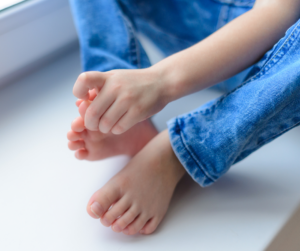
If you’ve ever dropped something on your foot or jammed it on something hard, you might have been close to breaking your toe. Broken toes are one of the most common breaks in the human body, and they can be seriously painful injuries that require prompt and careful rehabilitation.
That’s why at Kentlands Foot and Ankle Center, we are here to un-stub the toe fracture confusion, providing expert insight and advice along your path to better foot health.
Signs and Symptoms of a Broken Toe
Because a broken toe often causes immediate and severe pain, it’s helpful to distinguish it from other potential foot injuries like turf toe and toe sprains:
- Intense pain: Sharp and localized pain at the point of impact.
- Swelling: Rapid onset of swelling around the injured toe.
- Bruising: Discoloration may appear within a few hours.
- Deformity: The toe may appear visibly crooked or misshapen.
- Difficulty walking: Putting weight on the injured foot may be painful.
Prognosis for a Broken Toe
Most toe fractures typically heal within 4-6 weeks. However, the specific recovery time can vary depending on the severity of the fracture and the person’s overall foot health.
While most broken toes heal without complications, there is a small risk of developing arthritis in the affected toe in the future. Additionally, if the fracture is not properly aligned, it may result in long-term pain or deformity.
Treatment and Recovery
Most minor toe fractures can be treated at home with the RICE method (rest, ice, compression, elevation) and over-the-counter pain relievers prescribed by your podiatrist. In some cases, your podiatrist may recommend taping or splinting the toe to immobilize it and promote healing.
Crutches or boots are typically not necessary for a broken toe unless there are multiple fractures or associated injuries. However, it’s essential during recovery to avoid putting excessive weight on the injured foot. Physical therapy may also be recommended to gently regain strength and flexibility after the bone has healed.
Want to stay on top of your foot and ankle health this summer? We’re happy to help! Schedule a comprehensive foot examination with Kentlands Foot and Ankle Center podiatrist Dr. Jon M. Sherman. To schedule your appointment, please call our office at 301-825-9697.
-
Protect Your Feet from the Summer Sun

Just like the rest of your body, your feet are susceptible to sun damage. UV rays penetrate the layers of your skin, causing sunburn, premature aging, and increasing the risk of cancer. While the soles of your feet have thicker skin, the tops and ankles are vulnerable, especially for people who wear sandals or flip-flops regularly.
If we diligently protect our faces and arms with sunscreen, why should we neglect our feet? Here’s why you shouldn’t forget about protecting them from the sun’s harmful UV rays, according to our expert team at Kentlands Foot and Ankle Center.
The Risks of Sun-Exposed Feet
- Actinic Keratosis: These precancerous lesions appear as rough, scaly patches on skin exposed to the sun, especially during summer. While not cancerous themselves, they can develop into skin cancer if left untreated.
- Squamous Cell Carcinoma: This is a type of skin cancer that can develop on the sensitive areas of the feet. Early detection can decrease the risk of complications, so be aware of any changes in the appearance of your skin, such as new moles, persistent scaling, or bleeding.
- Age spots: These are flat, brown spots that commonly appear on sun-exposed areas, including the tops of the feet. While benign, they can be a cosmetic concern for some.
- Pre-existing skin conditions: Sun exposure can worsen existing skin conditions on the feet, such as eczema or psoriasis, leading to increased itching, inflammation, and discomfort.
Protecting Your Feet This Summer
- Sunscreen: Apply broad-spectrum sunscreen with SPF 30 or higher to the tops of your feet and ankles 15 minutes before sun exposure. Reapply every two hours, especially after swimming or sweating.
- Sun-Protective Footwear: Wear closed-toe shoes or sandals with straps that cover the tops of your feet. Look for materials like canvas or mesh that allow for ventilation while providing some sun protection.
- Examine Your Feet Regularly: Pay attention to any changes in the appearance of your skin, such as new moles, discolored spots, or changes in texture. If you notice anything concerning, consult a podiatrist.
Want to keep your feet happy and healthy this summer? We’re eager to help! Schedule a comprehensive foot examination with Kentlands Foot and Ankle Center podiatrist Dr. Jon M. Sherman. To schedule your appointment, please contact our office at 301-825-9697.
-
Beat the Sweat: How BOTOX® Can Help with Hyperhidrosis
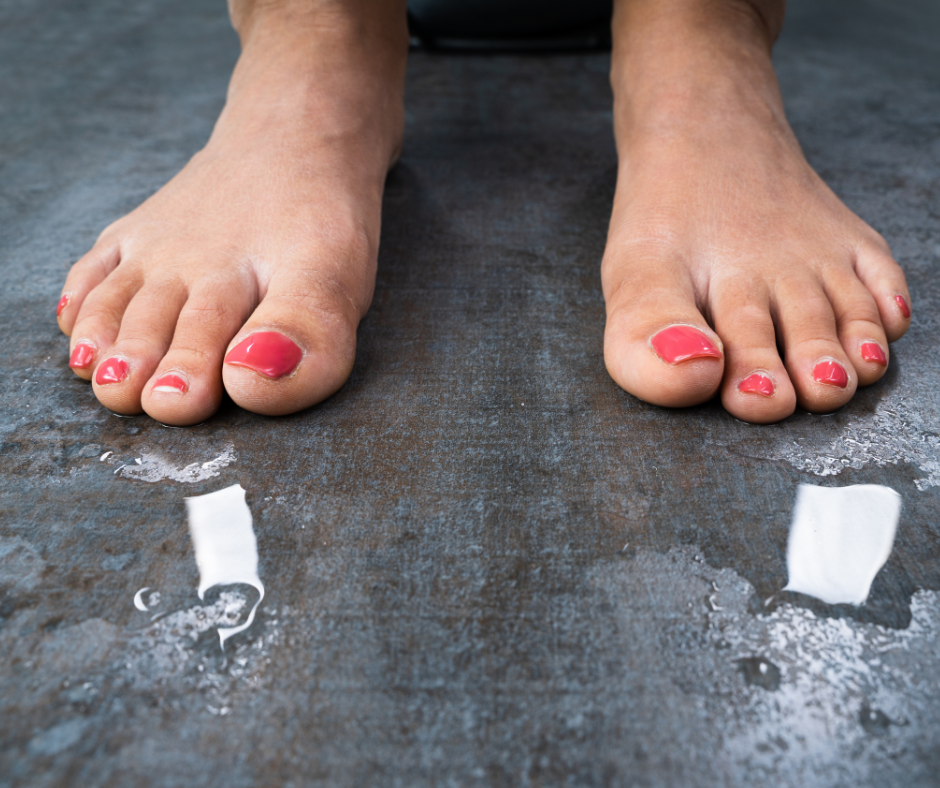
Sometimes, your body’s typical processes can go askew, leading normal actions like sweating or walking to become significantly more complicated in the worst of ways. Sweating, for example, plays a vital role in regulating body temperature. But for some, sweating goes beyond keeping cool and becomes a daily struggle known as hyperhidrosis.
Kentlands Foot & Ankle Center has put together a quick blog on the subject to help you stay cool and dry through the summer months. Read on to learn how you can handle excessive sweat with a few podiatric pointers courtesy of our expert team.
The Impact of Excessive Sweating
The constant fear of visible sweat can lead to social withdrawal and increased stress. Beyond social anxieties, excessive sweating can also have physical consequences:
- Cold and clammy skin: This can make movement uncomfortable while increasing your risk of calluses, blisters, or corns, which are serious problems for diabetics in particular. Clammy skin can also limit shoe choice.
- Smelly feet: This can be embarrassing and lead to self-consciousness, which in turn might make some affected individuals less physically active or socially outgoing.
- Dehydration: Excessive sweating can deplete electrolytes and fluids, leading to dehydration.
- Skin infections: Constant moisture can create an environment ripe for bacterial growth, increasing the risk of infections.
- Ruined clothes and shoes: Clothing or footwear made unusable due to excessive sweat can be a costly burden.
BOTOX® to the Rescue
Thankfully, those affected by excessive sweat have access to a proven solution.
- BOTOX®, known for its use in wrinkle reduction, can also be a game-changer for hyperhidrosis affecting the feet.
- It works by temporarily blocking nerve signals that trigger sweat glands in the targeted area.
- This leads to a significant reduction in sweat production, providing much-needed relief.
Taking Control of Your Sweat and Comfort
Hyperhidrosis and painful feet shouldn’t hold you back, but if it’s neglected for too long, you might find yourself with a persistent fungal infection, damaged skin, or worse. With BOTOX treatments for excessive sweating, you can regain confidence and comfort in your daily life.
Interested in learning more? We’re always happy to help! Schedule a comprehensive foot examination with Kentlands Foot and Ankle Center podiatrist Dr. Jon M. Sherman. To make your appointment, please call our office at 301-825-9697.
-
For Foot and Ankle Pain, Tailored Treatments Offer the Best of Both Worlds
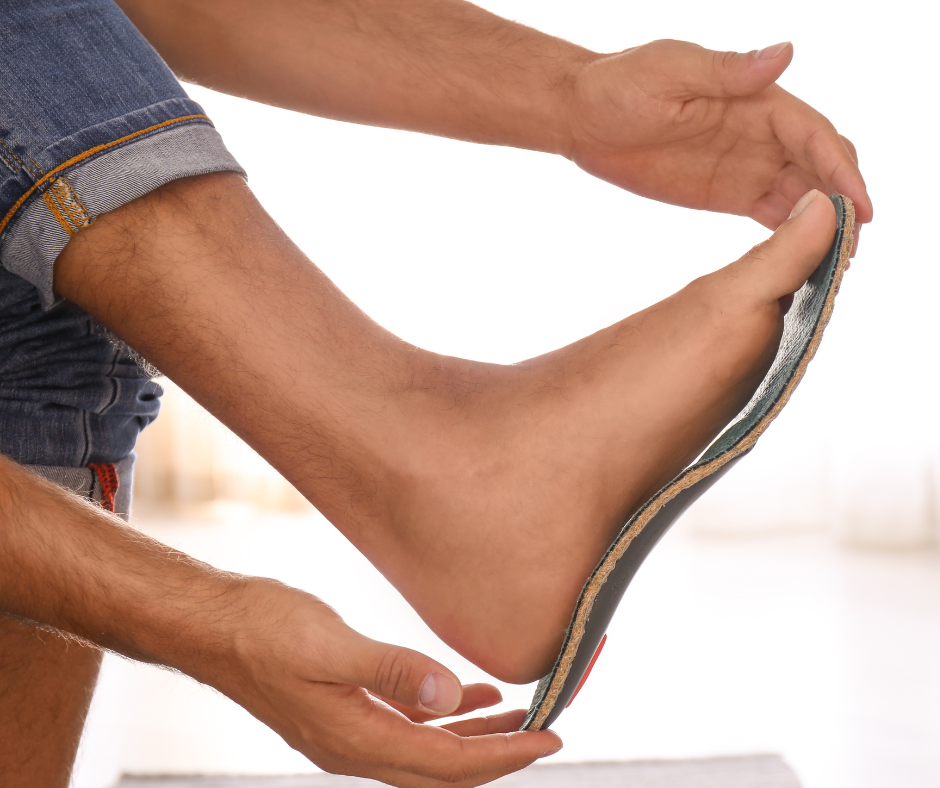
Foot pain can sideline even the most active individuals, but before you resign yourself to chronic discomfort, consider the wide variety of treatments available from your local podiatrist. With options ranging from the conservative to the innovative and everything in between, a DPM can restore balance and mobility while managing pain.
The key is finding the right approach for your specific needs! For this blog, the team at Kentland’s Foot and Ankle Center wants to keep you posted on a few of the most effective ones. Read on to learn more about the options available to you, from exciting newbies to tried-and-true standards.
Starting Simple: Rest, Therapy, and Orthotics
The first line of defense is often the simplest.
- Rest, ice, and pain medication might provide relief in the short term.
- Physical therapy strengthens supporting muscles and improves flexibility, addressing the root cause of pain and preventing future problems.
- Custom orthotics deserve special mention. By providing personalized support and correcting biomechanical imbalances, they can significantly improve comfort and function.
You can get the best of both worlds via a combined approach: A 2023 study published in the Journal of the American Podiatric Medical Association (JAPMA) found that physical therapy combined with custom orthotics was highly effective in reducing pain and improving function in patients with plantar fasciitis.
- High-tech and low-tech can also complement one another. For example, our team utilizes 3D orthotic scanning technology to create orthotics tailored to your unique foot shape.
- This ensures a superior fit and function compared to traditional casting methods.
Stepping Up: Advanced Techniques for Persistent Pain
If conservative measures don’t provide lasting relief, your podiatrist might recommend more advanced interventions.
- Shockwave therapy, for instance, utilizes sound waves to stimulate tissue healing and reduce inflammation.
- Studies have shown promise for its effectiveness in treating plantar fasciitis and Achilles tendonitis.
Sometimes, a minimally invasive surgical procedure might be the best approach.
- Many podiatrists are skilled surgeons, able to perform procedures like bunionectomy or hammertoe correction with minimal scarring and downtime involved.
Are you interested in learning more? We’re always happy to help! Schedule a comprehensive foot examination with Kentlands Foot and Ankle Center podiatrist Dr. Jon M. Sherman. To make your appointment, please call our office at 301-330-5666.
-
Fungal Toenail Troubles? Spring Forward with KeryFlex!
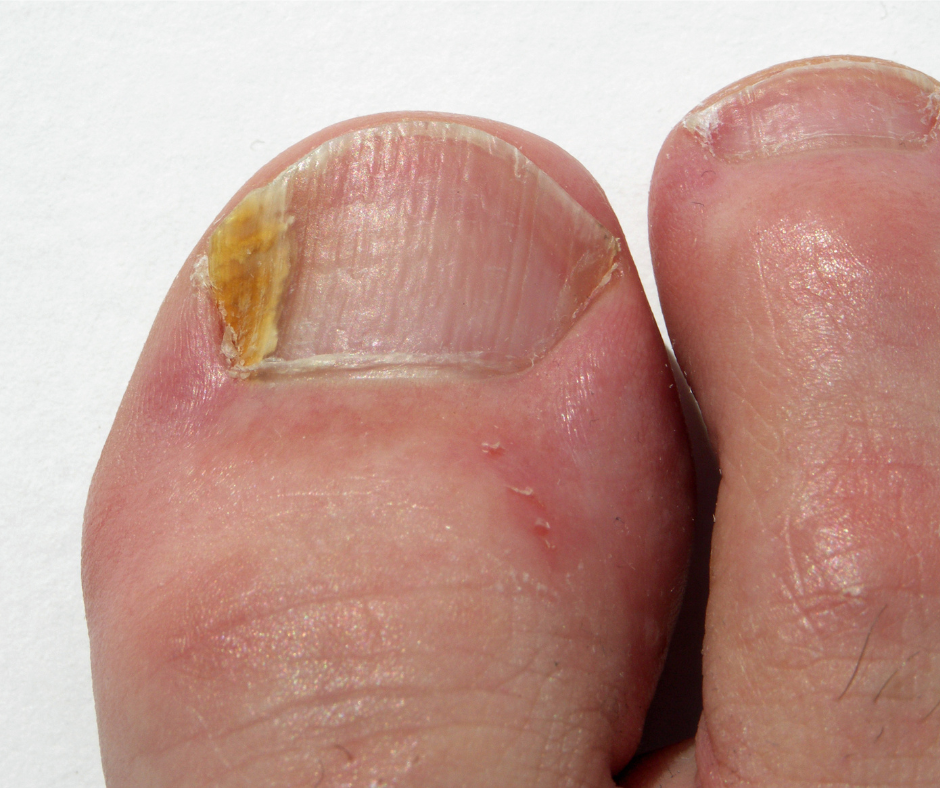
Spring has sprung! Yet, as folks embrace open-toed shoes and footwear, some must struggle with a pesky podiatric problem – fungal nails.
Also known as onychomycosis, these fungal infections commonly affect both toenails and fingernails. While topical and oral antifungal medications are available for treatment, they can take months to show results and often require ongoing use. Meanwhile, discolored, thickened nails can be a source of discomfort and embarrassment, preventing those afflicted from enjoying the carefree feeling of spring footwear.
That’s where the KeryFlex Nail Restoration System comes in! This blog will cover the ins and outs of this confidence-boosting treatment method, courtesy of the team at Kentlands Foot & Ankle Center.
A Confidence Booster for Your Feet
KeryFlex restores the appearance of damaged nails via a safe, painless, and in-office procedure.
- A specially formulated resin is applied directly to the area, creating a durable yet flexible artificial nail that mimics the look and feel of a healthy, natural one.
- Unlike some medications, KeryFlex provides an immediate cosmetic improvement, so you can ditch the closed-toe shoes with confidence!
Beyond Aesthetics: Complements Fungal Nail Treatment
While KeryFlex doesn’t treat the underlying fungal infection itself, it’s a valuable complement to other fungal nail treatments.
- It provides a protective barrier over the affected nail, which helps prevent fungus from spreading and improves the effectiveness of topical medications.
- Additionally, it promotes healthy nail growth by creating a stable base for the new nail to form underneath.
A Multitude of Benefits
- Durable and Flexible:
KeryFlex can withstand everyday wear and tear by moving in tandem with your feet and toes, allowing you to participate in your favorite spring activities worry-free.
- Non-Irritating:
KeryFlex bonds securely to the nail plate, so it doesn’t irritate surrounding skin.
- Complementary and Affordable:
KeryFlex works alongside traditional antifungal therapies to promote healthy nail growth. It’s also cheaper than current oral antifungals.
Don’t let fungal nails steal your spring sunshine! If you’re struggling with discolored or damaged toenails, consult with your podiatrist to see if KeryFlex is the right solution for you.
Interested in learning more? We’re always available and happy to help! Schedule a comprehensive foot examination with Kentlands Foot and Ankle Center podiatrist Dr. Jon M. Sherman. To make your appointment, please call our office at 301-330-5666
-
Keep Your Feet Flowing: Blood Flow and Circulation in the Lower Extremities

February is American Heart Month, a timely reminder to prioritize our cardiovascular well-being. However, while most focus remains on the heart itself, its connection to our feet and lower extremities tends to go unnoticed.
The truth is that healthy blood flow and circulation are crucial for happy, healthy feet. Let the team at Kentlands Foot & Ankle Center delve into this vital relationship for you! Together, we’ll explore how to keep your feet flowing freely.
Heart Health Basics
Your heart pumps tirelessly and constantly, sending oxygen-rich blood throughout your body. But that doesn’t mean there aren’t any problems.
- In terms of distance, your heart works hardest to send blood to your feet, which are as far away from it as possible.
- When this intricate system functions well, your feet receive the nutrients they need to stay healthy and function optimally.
- When something goes amiss, your feet are typically the first to find out.
When the Flow Filters
Disruptions to your circulation tend to translate into problems for your feet.
- Conditions like peripheral artery disease (PAD) – which affects nearly 34 million Americans – narrow arteries, restricting blood flow to the lower extremities.
- This can lead to symptoms such as pain, numbness, and even tissue damage in severe cases.
Circulation Education
Fortunately, several measures can promote healthy blood flow and circulation in your feet:
- Regular exercise, including walking, improves circulation throughout your body, including your lower extremities.
- Avoid tight shoes that constrict blood vessels in your feet.
- If you have diabetes or high blood pressure, work with your doctor to manage these conditions effectively.
- Consult a podiatrist promptly for any concerns like pain, numbness, or changes in skin color or texture.
When in doubt, it never hurts to consult a DPM with a proven reputation for knowing how to handle all kinds of foot and ankle complications!
Schedule a comprehensive foot examination with Kentlands Foot and Ankle Center podiatrist Dr. Jon M. Sherman. To make your appointment, please call our office at 301-330-5666.
RECENT POSTS
categories
- Uncategorized
- Featured Articles
- Foot Disorders
- Broken Ankle
- Broken Toe
- Fracture
- Foot Health
- Foot Care
- Arthritis
- Foot Pain
- Skin Cancer
- Podiatry Appointment
- Custom Orthotics
- Podiatrist
- Diabetes
- Gout
- Heart Health
- National Nutrition Month
- National Foot Health Awareness Month
- Foot Safety
- Foot and Ankle Injuries
- Falls Prevention
- Chronic Heel Pain
- Shoes
- Laser Therapy
- Quoted
- Physical Therapy
- KeryFlex
- Sweat
- Summer Foot Care
- Sports Injury
- ESWT
- Fungal Toenails
- Bunion
- Plantar Fasciitis


